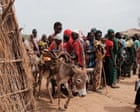
The recent weeks have seen a series of escalations in conflicts across various regions in the Middle East and North Africa, casting a somber shadow yet highlighting the resilience of communities caught amidst turmoil. From the traumatic events in Sudan to the ongoing tensions in Syria and Gaza, the situations call for a closer understanding of the complex dynamics at play.
In Sudan, the civil war’s toll continues to rise, with the Rapid Support Forces, a paramilitary group, reportedly responsible for the deaths of nearly 300 individuals in the North Kordofan state. The attacks, described by Sudanese activists as targeting villages devoid of military objectives, underscore the brutality and chaos gripping the region since the conflict’s onset in April 2023. This tragic chapter in Sudan’s history is marked by ongoing clashes between the paramilitary forces and the national army, exacerbating the humanitarian crisis and displacement of civilians.
Meanwhile, across the border in southern Syria, hostilities have intensified following deadly confrontations between local Druze militias and Bedouin clans in Sweida province. These clashes have drawn in government forces attempting to restore order, yet facing resistance from entrenched local armed groups. Amidst this, the Israeli military has reported striking military targets in Syria, further complicating the volatile landscape of alliances and antagonisms within the borderlands of this war-torn nation. These developments unfold against the backdrop of Syria’s long search for stability after years of civil conflict.
The situation in Gaza adds another layer of distressing reality as humanitarian concerns persist amidst continued violence. Recent Israeli airstrikes have resulted in 19 fatalities, including several children, in central Gaza. This tragic incident occurred at a water collection point, highlighting the risks faced by civilians even in their efforts to secure basic necessities. According to reports, the strike, aimed at a militant target, was miscalculated, causing unintended devastation to innocents who were present.
Furthermore, the occupied West Bank has been embroiled in heightened tensions and violence, with recent incidents including the killing of two young Palestinian men by Israeli settlers. One of the victims, Sayfollah “Saif” Musallet, a Palestinian-American, adds a poignant note to the tragedy as his family calls for an investigation into his death, illustrating the international dimensions and personal stories involved in these regional conflicts.
Each of these areas – Sudan, Syria, Gaza, and the West Bank – represents a unique yet interconnected tapestry of conflict, with roots deep in political, ethnic, and historical tensions. As the people living in these regions endure the hardships and uncertainties of conflict, international humanitarian efforts remain critical in addressing the immediate needs while diplomatic endeavors persist in seeking long-term resolutions.
The unfolding events in these regions thus call for a balanced and compassionate understanding, recognizing the complexities and the urgent need for peaceful dialogue. The shared hope across these contexts is for stability and safety, offering a future wherein communities can rebuild and flourish beyond the shadows of conflict.
Source: {link}
